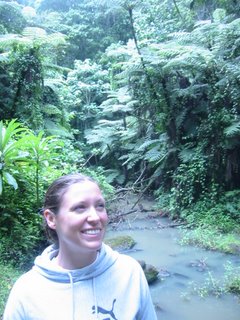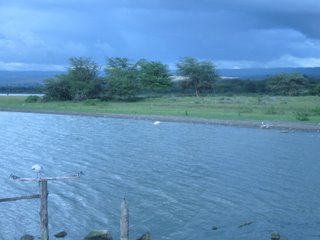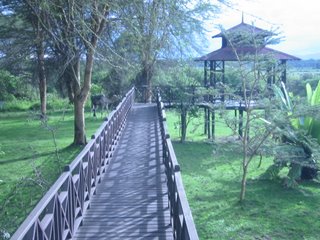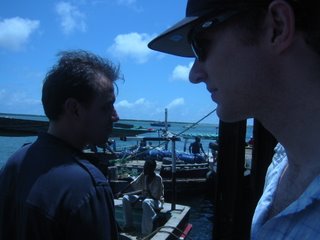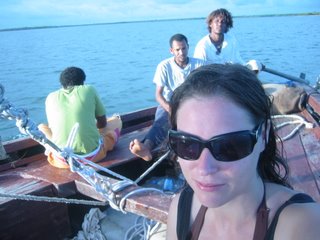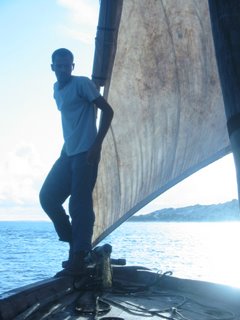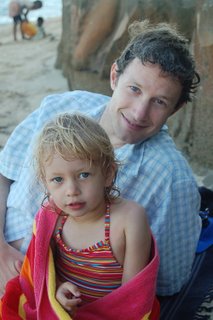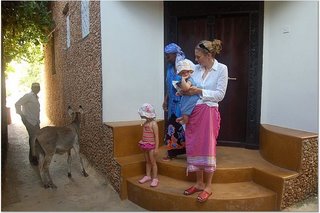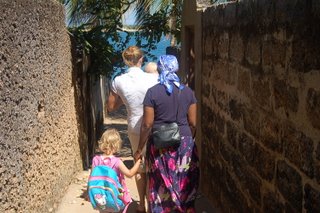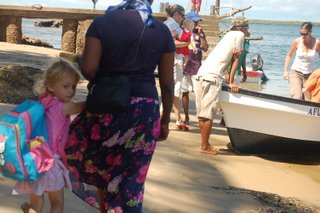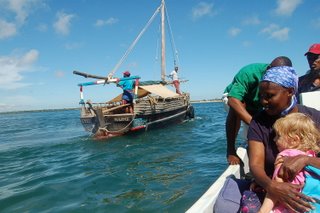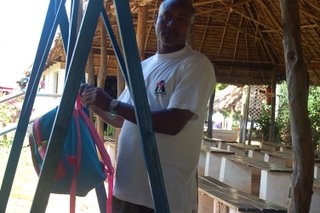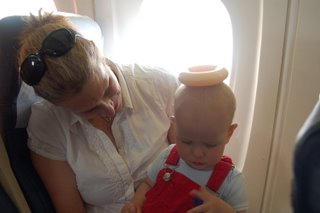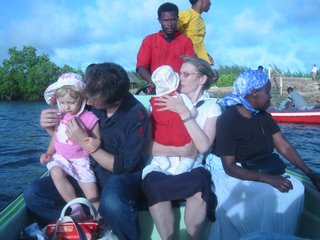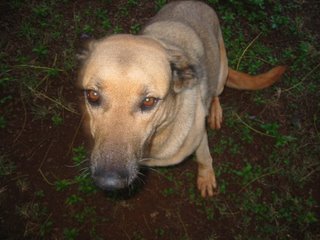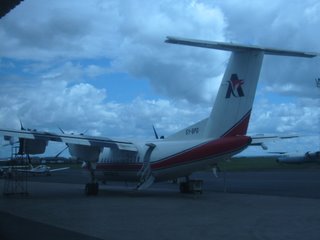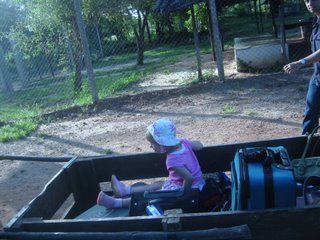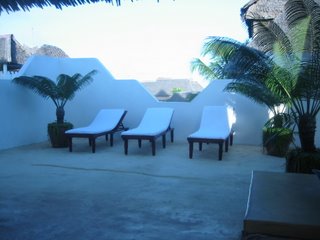 DAY 15 – (Mon)
DAY 15 – (Mon)
The next morning we woke to a personal wake up call at 6. Taking a minute on our porch to enjoy the peaceful still of the morning, we watched a crock slowly glide through the water, barely making a ripple. We continued on to have coffee with the hippos and then another, brief game drive. We enjoyed the indescribable sensation of witnessing the sunrise on the African savannah and were accompanied by four bounding buffalo running parallel to us through the golden grass along a stretch about a km long. Spectacular.
We returned to camp for another great breakfast, and packed to move onto to our next destination. We were supposed to meet an armed convoy at a particular intersection, as the stretch of road between Tsavo (where we were) and Amboseli (where we were heading) is apparently dangerous and prone to attacks by AK-47s wielding bandits. But through a series of communication errors, we missed the convoy and unwittingly ran the gauntlet through the dangerous stretch solo. Given the fact that all wazungu (whites) have been traveling through there in armed convoys for the last few years, I doubt there are really many ‘bandits’ still active there, but a bit of a thrill nonetheless. At a half-way check-point we met up with a different convoy and raced the rest of the way at speeds undoubtedly statistically more dangerous than any carjacking. Still, we made it to Amboseli safely, but our adventure was not over. Our map of the park was not great and didn’t include about 90% of the roads, so after a long search for petrol, we found ourselves at a dead end in a Masai village.

A group of friendly young Masai chatted us up, and tried to explain to Bradley that we were heading the wrong way and that we needed to head to the “that hill” pointing into the distance. Finally, one just jumped in the back of the Land Rover and drove 12 kms with us giving directions.
We made it to the Tortilis Lodge, again road weary, but in time for a late lunch. Again, the lodge was beautiful, but in a very different style from Finch. It was more open and manicured. Due to some confusion in the booking we were in a tent that was not what we paid for, and given their vacancies, the only alternative was the “family house” – quite an upgrade. The thing was huge with a beautiful deck looking over a watering hole, in front of what we would later discover was the stunning backdrop of Kilimanjaro.


After dropping our bags, we headed out with a guide in one of their vehicles this time (much smoother and easier on the back and way easier to see out of) for an evening game drive. Jumo, our guide, was mild mannered but very knowledgeable and calmly pointed out birds, tree species, and game as we drove. As we passed elephants grazing half-sunk in the swamp, he explained how the snow melts from Kili seep into the plains and support all of the biodiversity, adding ominously what was at the top of our minds – with global warming, the snow pack is expected to disappear within 20 years – “no snow, no Amboseli.”

He took us to a hyena den, full of pups right next to the road. Michelle had been requesting lions, and though he tempered our expectations heavily, we happened upon two lionesses and a cub, at quite a distance, but striking and exciting nonetheless. Heading home, feeling lucky and satisfied, we spotted a lone bull elephant meandering on an intersecting path to us with the dark blue and bright orange sunset horizon falling behind him. We stopped just in front of his path and he slowly, quietly, gracefully passed behind the car with a couple of meters. He paused momentarily, turned his head towards us flapped his ears and shook his head, just to demonstrate his power, before continuing on. Just then, awestruck, we looked up and the clouds had lifted from the peak of Kilimanjaro, revealing to us for the first time the equatorial snow cap. Words can do the moment no justice, so suffice it to say it was one of those moments.



We made it back well after dark, showered and headed to the lodge for dinner. In the bar we met a 3 friendly Canadians (again, virtually neighbors of Michelle’s, small world) who were making a documentary on global warming. They had been shooting at the COP and were here to get Kilimanjaro footage. We obviously had lots to talk about and joined them for an exciting dinner sharing experiences and thoughts on sustainability and throwing around ideas for the movie. We did our best to stay up and hang out, but the early mornings and dusty days on the roads were catching up.
DAY 16 – Return to Nairobi (Tues)
 Again, a personal wake-up call at 6, only this time with coffee. We threw on some clothes and stepped out on the porch, only to be greeted by the striking spectacle of Kilimanjaro, fully clear of cloud cover. We sat and had our coffee, gazing at the mountain and watching a crane hunt in the little watering hole in our front yard. We joined Jumo again for a morning drive and watched the plains wake up and turn golden. We hiked observation hill and took in a 360 view of the swamps of Amboseli. Ready to call it a morning and head back to camp for breakfast, we got back in the vehicle, and just down the road spotted a cheetah out for a morning hunt. It was another lucky sighting and we spent about 20 minutes watching from about 50 meters as she stalked around, sat up on high ground, had a look around, and generally just showed off. It was amazing.
Again, a personal wake-up call at 6, only this time with coffee. We threw on some clothes and stepped out on the porch, only to be greeted by the striking spectacle of Kilimanjaro, fully clear of cloud cover. We sat and had our coffee, gazing at the mountain and watching a crane hunt in the little watering hole in our front yard. We joined Jumo again for a morning drive and watched the plains wake up and turn golden. We hiked observation hill and took in a 360 view of the swamps of Amboseli. Ready to call it a morning and head back to camp for breakfast, we got back in the vehicle, and just down the road spotted a cheetah out for a morning hunt. It was another lucky sighting and we spent about 20 minutes watching from about 50 meters as she stalked around, sat up on high ground, had a look around, and generally just showed off. It was amazing.
 Sad to leave we headed back, got packed up and took a quick tour of the organic garden at the camp (that's a basil 'tree') - then we made the long drive back to Nairobi, for a joyous reunion with the little ones.
Sad to leave we headed back, got packed up and took a quick tour of the organic garden at the camp (that's a basil 'tree') - then we made the long drive back to Nairobi, for a joyous reunion with the little ones.
DAY 17 – T-day prep (Weds)
A slow day of recovering, unpacking & catching up on work – we also did a big grocery shop in preparation for an African Thanksgiving. We had a big bird lined up – and far and a way the highlight of the day was Em & I trying to figure out how to brine a turkey, following our brother emailed directions from a year earlier. After some clever use of a trash bag and a cooler, as well as some serious refrigerator reshuffling, we got it taken care of… well worth it.
DAY 18 – Thanksgiving, rain / water tank, turkey, intermitten power (Thurs)

It was pouring in the morning, and ironically we had no running water. Evans and I had a bucket water-catchments system going to refill the tank, but the pump still wasn’t working – this of course wasn’t helped by the fact that the electricity was intermittent. This fact also didn’t help us cook the bird – but we persevered. And after 6 or 7 hours – we had a fully cooked turkey (as best we could tell by candle-light). Em set a beautiful table, Mich had mixed up some unreal sage stuffing, and Agnus made her famous mashed potatoes. All in all a raging success – and as we ate we were joined by a Kenyan and a Norwegian, who were no doubt blown away by the dedication to our national heritage & the sheer magnitude of the spread – making it a truly international affair.

DAY 19 – Bizarre Bazaar, travel
Hardly believing it was over, we spent the final day at the Bizarre Bazaar, an annual pre-Christmas shopping fair for (mostly white) Kenyans. It was cool to see all the various goods & wears from around the country – everything from baskets & home stuff to clothes, art & music. We spent the evening packing, enjoying one final meal & some sad good-byes. All in all it was an unforgettable trip – and so much thanks & love to the fam for all the hospitality & so much more. Stay going.


























